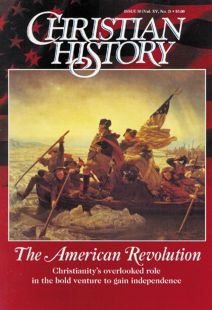Christianity and the American Revolution: Recommended Resources
The following books will be especially rewarding to the diligent reader.
Revival Background
Arguing for an explicit relationship between the Great Awakening and the Revolution are:
- Alan E. Heimert, Religion and the American Mind from the Great Awakening to the Revolution (Harvard, 1966);
- Patricia U. Bonomi, Under the Cope of Heaven: Religion, Society, and Politics in Colonial America (Oxford, 1986); and
- Harry S. Stout, The New England Soul: Preaching and Religious Culture in Colonial New England (Oxford, 1986).
A Religious Revolution
Penetrating essays linking religious thought to the Revolution are found in:
- Sidney E. Mead, The Lively Experiment: The Shaping of Christianity in America (Harper and Row, 1963) and
- Jerald C. Brauer, ed., Religion and the American Revolution (Fortress, 1976).
- Mark A. Noll, Christians in the American Revolution (Eerdmans, 1977) surveys the varied Christian responses to the Revolution.
- Edwin S. Gaustad, Faith of Our Fathers: Religion and the New Nation (Harper & Row, 1987) surveys these men’s religious beliefs in general, and in particular in Thomas Jefferson: A Religious Biography (Eerdmans, 1996).
For the interaction between republicanism and religious thought, see:
- Nathan O. Hatch, The Sacred Cause of Liberty: Republican Thought and the Millennium in Revolutionary New England (Yale, 1977) and
- Ruth Bloch, Visionary Republic: Millennial Themes in American Thought, 1756–1800 (Cambridge, 1985).
- Russell E. Richey and Donald G. Jones, eds., American Civil Religion (Harper & Row, 1974) feature essays that consider how the revolutionary experience shaped America’s civil religion.
Out of the Mainstream
- Rosemary Radford Ruether and Rosemary Skinner Keller, eds., Women and Religion in America, vol. 2, The Colonial and Revolutionary Periods (Harper & Row, 1983); see especially Keller’s chapter.
- Ronald Hoffman and Peter J. Albert, eds., Religion in a Revolutionary Age (Virginia, 1994) contains chapters on the religious experiences of women, blacks, workers, and evangelicals in Revolutionary America.
- Charles H. Metzer, Catholics and the American Revolution (Loyola, 1962).
- Stephen A. Marini, The Radical Sects of Revolutionary New England (Harvard, 1982).
- Peter Brock, Pacificism in the United States: From the Colonial Era to the First World War (Princeton, 1968).
By David W. Kling
[Christian History originally published this article in Christian History Issue #50 in 1996]
David W. Kling is assistant professor of religious studies at the University of Miami and author of A Field of Divine Wonders: The New Divinity and Village Revivals in Northwestern Connecticut, 1792–1822 (Penn State, 1993).Next articles
Heresy in the Early Church: Did You Know?
Remarkable or little-known facts about heresy in the early church.
Tony LaneFinding the Truth
How the earliest church decided Marcion and the Gnostics, among others, were wrong.
Justo González, Jr.Heresy in the Early Church: A Gallery of Malcontents for Christ
The mixed motives and odd teachings of four notorious heretics.
Stephen MillerSupport us
Christian History Institute (CHI) is a non-profit Pennsylvania corporation founded in 1982. Your donations support the continuation of this ministry
Donate



